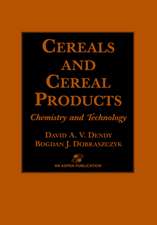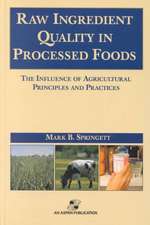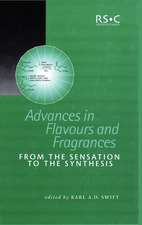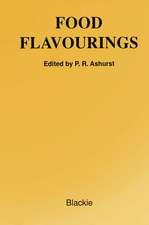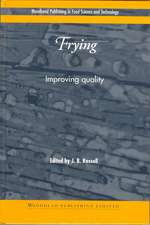Fundamentals of Food Process Engineering
Autor R. T. Toledoen Limba Engleză Paperback – 17 mai 2012
Preț: 407.01 lei
Nou
Puncte Express: 611
Preț estimativ în valută:
77.89€ • 84.58$ • 65.43£
77.89€ • 84.58$ • 65.43£
Carte tipărită la comandă
Livrare economică 22 aprilie-06 mai
Preluare comenzi: 021 569.72.76
Specificații
ISBN-13: 9781461570578
ISBN-10: 1461570573
Pagini: 624
Ilustrații: XV, 602 p.
Dimensiuni: 155 x 235 x 33 mm
Greutate: 0.86 kg
Ediția:Softcover reprint of the 2nd ed. 1991
Editura: Springer Us
Colecția Springer
Locul publicării:New York, NY, United States
ISBN-10: 1461570573
Pagini: 624
Ilustrații: XV, 602 p.
Dimensiuni: 155 x 235 x 33 mm
Greutate: 0.86 kg
Ediția:Softcover reprint of the 2nd ed. 1991
Editura: Springer Us
Colecția Springer
Locul publicării:New York, NY, United States
Public țintă
ResearchDescriere
Ten years after the publication of the first edition of Flllldmntntais of Food Process Engineering, there have been significant changes in both food science education and the food industry itself. Students now in the food science curric ulum are generally better prepared mathematically than their counterparts two decades ago. The food science curriculum in most schools in the United States has split into science and business options, with students in the science option following the Institute of Food Technologists' minimum requirements. The minimum requirements include the food engineering course, thus students en rolled in food engineering are generally better than average, and can be chal lenged with more rigor in the course material. The food industry itself has changed. Traditionally, the food industry has been primarily involved in the canning and freezing of agriCUltural commodi ties, and a company's operations generally remain within a single commodity. Now, the industry is becoming more diversified, with many companies involved in operations involving more than one type of commodity. A number of for mulated food products are now made where the commodity connection becomes obscure. The ability to solve problems is a valued asset in a technologist, and often, solving problems involves nothing more than applying principles learned in other areas to the problem at hand. A principle that may have been commonly used with one commodity may also be applied to another commodity to produce unique products.
Cuprins
1 Review of Mathematical Principles and Applications in Food Processing.- Graphing and Fitting Equations to Experimental Data.- Roots of Equations.- Differential Calculus.- Integral Calculus.- Problems.- Suggested Reading.- 2 Units and Dimensions.- Definition of Terms.- Systems of Measurement.- The SI System.- Conversion of Units.- The Dimensional Constant (gc).- Determination of Appropriate SI Units.- Dimensional Consistency of Equations.- Conversion of Dimensional Equations.- Problems.- Suggested Reading.- 3 Material Balances.- Basic Principles.- Material Balance Problems Involved in Dilution, Concentration, and Dehydration.- Blending of Food Ingredients.- Multistage Processes.- Problems.- Suggested Reading.- 4 Gases and Vapors.- Equations of State for Ideal and Real Gases.- Thermodynamics.- Vapor-Liquid Equilibrium.- Problems.- Suggested Reading.- 5 Energy Balances.- General Principles.- Energy Terms.- Heat.- Properties of Saturated and Superheated Steam.- Heat Balances.- Problems.- Suggested Reading.- 6 Flow of Fluids.- The Concept of Viscosity.- Rheology.- Continuous Viscosity Monitoring and Control.- Flow of Falling Films.- Transportation of Fluids.- Problems.- Suggested Reading.- 7 Heat Transfer.- Mechanisms of Heat Transfer.- Temperature-Measuring Devices.- Steady-State Heat Transfer.- Local Heat Transfer Coefficients.- Unsteady-State Heat Transfer.- Problems.- Suggested Reading ö..- 8 Kinetics of Chemical Reactions in Foods.- Theory of Reaction Rates.- Types of Reactions.- Enzymatic Reactions.- Reaction Order.- The Reaction Rate Constant.- Temperature Dependence of Reaction Rates.- Problems.- Suggested Reading.- 9 Thermal Process Calculations.- Processes and Systems for Stabilization of Foods for Shelf Stable Storage: Systems Requirements.- Microbiological Inactivation Rates at Constant Temperature.- Effect of Temperature on Thermal Inactivation of Microorganisms.- Sterilization of Continuously Flowing Fluids.- Sterilizing Value of Process Expressed as F0.- Thermal Process Calculations for Canned Foods.- Broken Heating Curves.- Quality Factor Degradation.- Problems.- Suggested Reading.- 10 Refrigeration.- Mechanical Refrigeration System.- The Refrigeration Cycle on the Pressure Enthalpy Diagram for a Given Refrigerant.- Example Problems on the Use of Refrigerant Charts.- The Condenser and Evaporator.- The Compressor.- Refrigeration Load.- Commodity Storage Requirements.- Controlled Atmosphere, Storage.- Problems.- Suggested Reading.- 11 Evaporation.- Single Effect Evaporators.- Improving the Economy of Evaporators.- Essence Recovery.- Problems.- Suggested Reading.- 12 Dehydration.- Water Activity.- Mass Transfer.- Psychrometiy.- Simultaneous Heat and Mass Transfer in Dehydration.- The Stages of Drying.- Prediction of Drying Times from Drying Rate Data.- Spray Drying.- Freeze Diying.- Problems.- Suggested Reading.- 13 Physical Separation Processes.- Filtration.- Sieving.- Gravity Separations.- Problems.- Suggested Reading.- 14 Extraction.- General Principles.- Diffusion.- Solubility.- Equilibrium.- Solid Liquid Extraction: Leaching.- Supercritical Fluid Extraction.- Problems.- Suggested Reading.- Appendixes.- Appendix A-1. Conversion Factors Expressed as a Ratio.- Appendix A-2. Properties of Superheated Steam.- Appendix A-3. Saturated Steam Tables—English Units.- Appendix A-4. Saturated Steam Tables—Metric Units.


